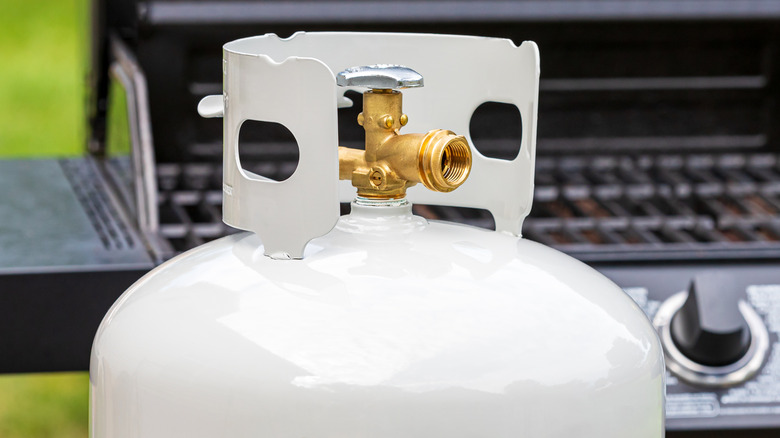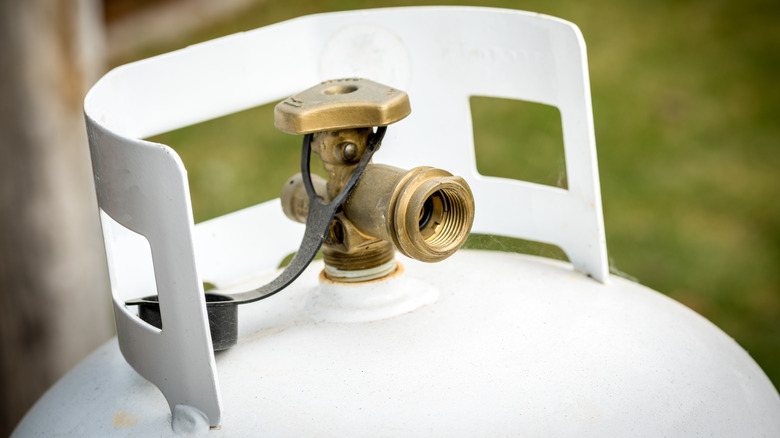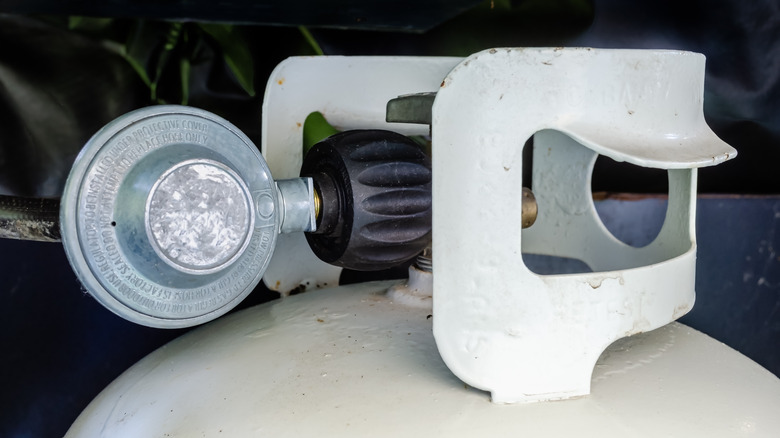The Hot Water Hack To Make Sure Your Grill Is Ready For Cooking
When you're getting ready to go camping, you can float your little propane tank in some water and mark the waterline to figure out how much propane is left in the tank. Because of the buoyancy of the trapped air inside the tank, it will float at the fill-line. But if you're getting ready to grill at home with a big 20-pounder and you're not sure how much fuel you have, that hack is way less practical. Since running out of fuel halfway through cooking is a surefire way to put a damper on your dinner, it's still important to figure out how much fuel you have before you ignite. So, what do you do?
Grab a glass of hot water – it shouldn't be boiling, but it should be plenty hot, so that it's easy to "read" — and pour it over the side of your propane tank. As you then run your hand down over the wet tank, the liquid will be warm where the tank is empty and cold where it's full.
The cool science behind this hack
Inside your propane tank is a liquid under pressure. As you use propane while cooking, it loses pressure and the propane vaporizes, becoming a gas that you cook with. Propane vaporizes at -44 degrees Fahrenheit, when not pressurized, which you might notice is a bit chillier than your ambient deck-grilling temp. However, when contained at a high pressure, the propane remains liquid even at room temperature.
Per the second law of thermodynamics, the transfer of heat moves from hot to cold, and the heat from the hot water you pour on your tank is sapped right out when it hits the propane (or rather, the metal touching the propane). Liquid propane in particular has a high "specific heat," which basically means it easily absorbs a lot of warmth (through the metal). So, pouring hot water on the tank is a really efficient and easy way to use the laws of science to make sure you'll be able to finish cooking dinner!
Incidentally, if you've ever noticed your propane tanks frosting up while you're cooking, it's because the rate of liquid conversion is less than the rate of vapor withdrawal. The propane pulls heat from the air around the tank (through the metal) as it vaporizes, and the faster it's vaporizing, the more heat it draws from the environment. If the outside of the tank gets chilly enough, frost will form. Slowing down the output will keep the tank and lines from freezing up.
Other ways you can check propane levels
Although this hot water trick is probably the easiest one, it's admittedly not the most exact. If you want to know precisely how much fuel is left, there are other ways to check your tank's levels. Chances are that if you look at your propane tank, it features a pair of numbers stamped into its handle: water capacity (W.C.) and tare weight (T.W.). The tare weight is the heaviness of the tank itself. A standard 20-pound tank holds 20 pounds of propane but actually weighs roughly 17 pounds. So, by weighing your propane tank and subtracting the tare weight from the number on the scale, you can figure out exactly how many pounds of propane remain.
What you may have seen at your grill-master friend's house, though, is an inline gauge. This installs between the tanks' cut-off valve and the grill's gas line, and it will read the pressure inside the tank then visually convert this pressure-reading to a fullness measure.
To figure out how long that amount of propane will last you, you need to know the B.T.U. (British Thermal Units) of your grill, or how much power it uses. There exist some easy online calculators to help with that conversion. Come prepared with this knowledge and you'll end up with plenty of extra time to grill the best burger patties ever.


